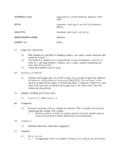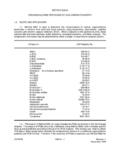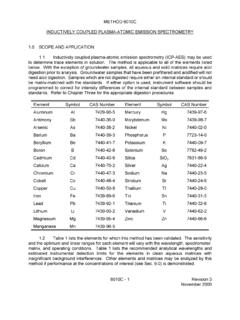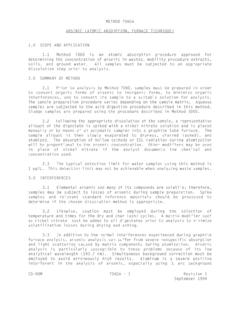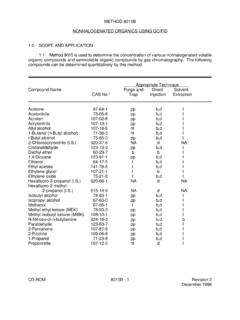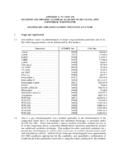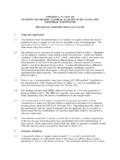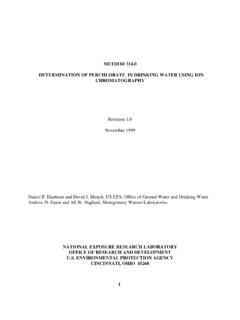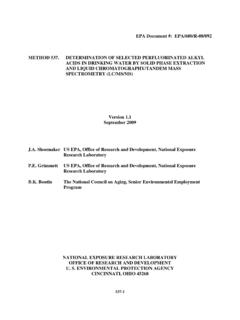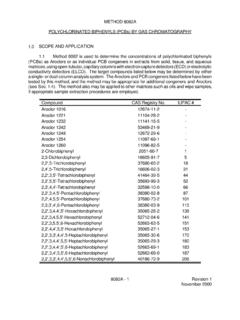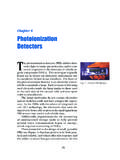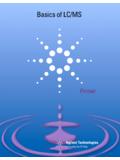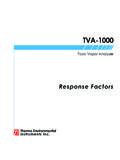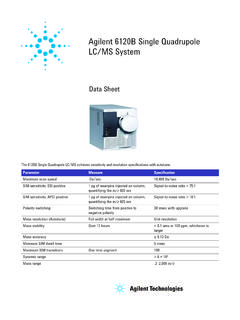Transcription of METHOD 502.2 VOLATILE ORGANIC COMPOUNDS IN WATER …
1 ORGANIC COMPOUNDS IN WATER BY PURGE AND TRAPCAPILLARY COLUMN GAS chromatography with PHOTOIONIZATIONAND electrolytic conductivity detectors IN SERIESR evision Edited by Munch (1995) Slater, Jr. and Ho - METHOD , Revision (1986) Ho - METHOD , Revision (1989)NATIONAL EXPOSURE RESEARCH LABORATORYOFFICE OF RESEARCH AND ENVIRONMENTAL PROTECTION AGENCYCINCINNATI, OHIO 45268 METHOD ORGANIC COMPOUNDS IN WATER BY PURGE AND TRAP CAPILLARY COLUMN GAS chromatography with photoionization AND electrolytic conductivity detectors IN SERIES AND is a general purpose METHOD for the identification and simultaneousmeasurement of purgeable VOLATILE ORGANIC COMPOUNDS in finished drinking WATER ,raw source WATER , or drinking WATER in any treatment stage.
2 The METHOD is1-3applicable to a wide range of ORGANIC COMPOUNDS , including the fourtrihalomethane disinfection by-products, that have sufficiently high volatility andlow WATER solubility to be efficiently removed from WATER samples with purge andtrap procedures. The following COMPOUNDS can be determined by this NumberChemical Abstract ServicesBenzene71-43-2 Bromobenzene108-86-1 Bromochloromethane74-97-5 Bromodichloromethane75-27-4 Bromoform75-25-2 Bromomethane74-83-9n-Butylbenzene104-51- 8sec-Butylbenzene135-98-8tert-Butylbenze ne98-06-6 Carbon Tetrachloride56-23-5 Chlorobenzene108-90-7 Chloroethane75-00-3 Chloroform67-66-3 Chloromethane74-87-32-Chlorotoluene95-49 -84-Chlorotoluene106-43-4 Dibromochloromethane124-48-11,2-Dibromo- 3-Chloropropane96-12-81,2-Dibromoethane1 06-93-4 Dibromomethane74-95-31,2-Dichlorobenzene 95-50-11,3-Dichlorobenzene541-73-11,4-Di chlorobenzene106-46-7 Dichlorodifluoromethane75-71-8 AnalyteRegistry NumberChemical Abstract ,1-Dichloroethane75-34-31,2-Dichloroetha ne107-06-21.
3 1-Dichloroethene75-35-4cis-1,2-Dichloroe thene156-59-4trans-1,2-Dichloroethene156 -60-51,2-Dichloropropane78-87-51,3-Dichl oropropane142-28-92,2-Dichloropropane590 -20-71,1-Dichloropropene563-58-6cis-1,3- Dichloropropene10061-01-5trans-1,3-Dichl oropropene10061-02-6 Ethylbenzene100-41-4 Hexachlorobutadiene87-68-3 Isopropylbenzene98-82-84-Isopropylbenzen e99-87-6 Methylene Chloride75-09-2 Naphthalene91-20-3 Propylbenzene103-65-1 Styrene100-42-51,1,2,2-Tetrachloroethane 630-20-61,1,1,2-Tetrachloroethane79-34-5 Tetrachloroethene127-18-4 Toluene108-88-31,2,3-Trichlorobenzene87- 61-61,2,4-Trichlorobenzene120-82-11,1,1- Trichloroethane71-55-61,1,2-Trichloroeth ane79-00-5 Trichloroethene79-01-6 Trichlorofluormethane75-69-41,2,3-Trichl oropropane96-18-41,2,4-Trimethylbenene95 -63-61,3,5-Trimethylbenzene108-67-8 Vinyl METHOD is applicable to the determination of total trihalomethanes and othervolatile ORGANIC COMPOUNDS (VOCs).
4 METHOD detection limits (MDLs) are4compound and instrument dependent and vary from g/L. The applicable concentration range of this METHOD is alsocompound and instrument dependent and is approximately that are inefficiently purged from WATER will not be detected at low concentrations, but they can be measured with acceptable accuracyand precision when present in sufficient of the three isomeric xylenes may not be resolved on the capillary column,and if not, must be reported as isomeric OF VOLATILE ORGANIC COMPOUNDS with low WATER solubility are extracted(purged) from the sample matrix by bubbling an inert gas through a 5 mLaqueous sample. Purged sample components are trapped in a tube containingsuitable sorbent materials.
5 When purging is complete, the sorbent tube is heatedand backflushed with helium to thermally desorb trapped sample componentsonto a capillary gas chromatography (GC) column. The column is temperatureprogrammed to separate the METHOD analytes which are then detected with aphotoionization detector (PID) and an electrolytic conductivity detector (ELCD)placed in series. Analytes are quantitated by procedural standard calibration(Section ). are made by comparison of the retention times of unknown peaksto the retention times of standards analyzed under the same conditions used forsamples. Additional confirmatory information can be gained by comparing therelative response from the two detectors .
6 For absolute confirmation, a gaschromatography/ mass spectrometry (GC/MS) determination according toUSEPA METHOD is METHOD requires the use of a PID to measure target analytes that cannot bemeasured with an electrolytic conductivity detector. If only halogenated analytes,such as the trihalomethanes are to be measured, a PID is not Standard (IS) -- A pure analyte(s) added to a solution in knownamount(s) and used to measure the relative responses of other METHOD analytesand surrogates that are components of the same solution. The internal standardmust be an analyte that is not a sample Analyte (SA) -- A pure analyte(s), which is extremely unlikely to befound in any sample, and which is added to a sample aliquot in knownamount(s) before extraction and is measured with the same procedures used tomeasure other sample components.
7 The purpose of a surrogate analyte is tomonitor METHOD performance with each Duplicates (LD1 and LD2) -- Two sample aliquots taken in theanalytical laboratory and analyzed separately with identical procedures. Analysesof LD1 and LD2 give a measure of the precision associated with laboratoryprocedures, but not with sample collection, preservation, or storage Duplicates (FD1 and FD2) -- Two separate samples collected at the sametime and place under identical circumstances and treated exactly the samethroughout field and laboratory procedures. Analyses of FD1 and FD2 give ameasure of the precision associated with sample collection, preservation andstorage, as well as with laboratory Reagent Blank (LRB) -- An aliquot of reagent WATER that is treatedexactly as a sample including exposure to all glassware, equipment, solvents,reagents, internal standards, and surrogates that are used with other LRB is used to determine if METHOD analytes or other interferences arepresent in the laboratory environment, the reagents, or the Reagent Blank (FRB)
8 -- Reagent WATER placed in a sample container in thelaboratory and treated as a sample in all respects, including exposure to samplingsite conditions, storage, preservation and all analytical procedures. The purposeof the FRB is to determine if METHOD analytes or other interferences are presentin the field Performance Check Solution (LPC) -- A solution of METHOD analytes,surrogate COMPOUNDS , and internal standards used to evaluate the performanceof the instrument system with respect to a defined set of METHOD Fortified Blank (LFB) -- An aliquot of reagent WATER to which knownquantities of the METHOD analytes are added in the laboratory. The LFB isanalyzed exactly like a sample, and its purpose is to determine whether themethodology is in control, and whether the laboratory is capable of makingaccurate and precise measurements at the required METHOD detection Fortified Sample Matrix (LFM) -- An aliquot of an environmentalsample to which known quantities of the METHOD analytes are added in thelaboratory.
9 The LFM is analyzed exactly like a sample, and its purpose is todetermine whether the sample matrix contributes bias to the analytical background concentrations of the analytes in the sample matrix must bedetermined in a separate aliquot and the measured values in the LFM correctedfor background Standard Solution -- A concentrated solution containing a single certifiedstandard that is a METHOD analyte, or a concentrated solution of a single analyteprepared in the laboratory with an assayed reference compound. Stock standardsolutions are used to prepare primary dilution Dilution Standard Solution (PDS) -- A solution of several analytesprepared in the laboratory from stock standard solutions and diluted as neededto prepare calibration solutions and other needed analyte Standard (CAL) -- A solution prepared from the primary dilutionstandard solution and stock standard solutions of the internal standards andsurrogate analytes.
10 The CAL solutions are used to calibrate the instrumentresponse with respect to analyte Control Sample (QCS) -- A sample matrix containing METHOD analytes ora solution of METHOD analytes in a WATER miscible solvent which is used to fortifyreagent WATER or environmental samples. The QCS is obtained from a sourceexternal to the laboratory, and is used to check laboratory performance withexternally prepared test Standard Calibration -- A calibration METHOD where aqueouscalibration standards are prepared and processed ( , purged,extracted, and/orderivatized) in exactly the same manner as a sample. All steps in the processfrom addition of sampling preservatives through instrumental analyses areincluded in the calibration.
